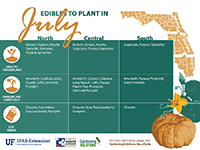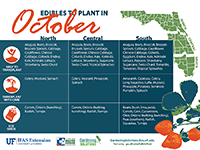Vegetable Gardening by Season
A vegetable hand-picked from your own garden tastes better than anything you can buy in a store. And here in Florida, home gardeners can grow vegetables all year long. Home gardens are convenient and may encourage you and your family to eat more fresh vegetables. The choices are endless, with vegetables of all sizes, colors, and shapes.
Start with a plan: decide what vegetables you want to plant, and where in your garden they'll be located. Make sure your site gets plenty of sun (at least six hours) and is near a source of water.
Get your soil tested to find out what nutrients it needs. Your county Extension office can help with this process. Purchase or start your own transplants or plant seeds directly in the soil. Water and fertilize as needed, and keep an eye out for pests.
The most important thing when beginning is to pay close attention to planting dates. Where you live within the state will affect that—planting dates for North, Central, and South Florida are very different. For more month-by-month gardening tips, check out Florida Gardening Calendars. Three different editions of the calendar provide specific tips for each of Florida's gardening regions—North, Central, and South.
UF/IFAS Publications
- Florida Vegetable Gardening Guide
- Central Florida Gardening Calendar
- North Florida Gardening Calendar
- South Florida Gardening Calendar
- Vegetables A - Z
Spring

There's nothing like having homegrown vegetables right at your back door, and spring is the perfect time to prepare your beds for vegetables. If this will be your first vegetable garden, you may find Getting Started with Your Vegetable Garden very helpful.
Spring crops include sweet corn, cucumber, tomato, watermelon, and several kinds of beans. For best results, choose varieties recommended for Florida.
You can plant seeds directly in the soil, use transplants, or start your own transplants six to eight weeks before planting time. For spring gardens in North and Central Florida, the planting time for most frost tender plants is in March. If you plant earlier, be prepared to cover your tender vegetables to protect them from late frosts. Frost hardy vegetables may be planted much earlier. Of course, in South Florida, you can plant "spring" vegetables in the fall and winter, up until February or March. Plant early enough so that your vegetables have time to mature before the heat of summer kicks in.
See Table 3 in the Florida Vegetable Gardening Guide for planting dates for specific crops.
Summer

What to Plant in July: See our full list of "What to Plant" infographics
If you're up for the heat and humidity, you can even grow vegetables in the summer.
A handful of vegetables will do well in the summer heat, including sweet potatoes, southern peas, cherry tomatoes, and okra. There are also some lesser-known tropical vegetables you can try, like cassava or Malabar spinach. Some spring crops like peppers and eggplant may continue into the summer. As long as the plants are healthy, there's no need to remove them if they're still producing fruit.
If you prefer to give your garden a rest during the summer, take advantage of the summer sun to solarize the soil. This kills nematodes, weeds, and other harmful pests with heat. Read more about soil solarization.
Fall

What to Plant in October: See our full list of "What to Plant" infographics
In Florida, fall is an excellent time to start a vegetable garden. Cool-season vegetables to plant in October include broccoli, lettuce, carrots, Brussels sprouts, and radishes.
If you’re planting in an area already used for spring and summer crops, be careful to remove all dead or diseased plant matter, including roots.
You may want to have your soil re-tested to check the pH level and to determine what nutrients you might need to add. Till your soil a few weeks before planting, and then add organic matter, such as cow manure or compost.

